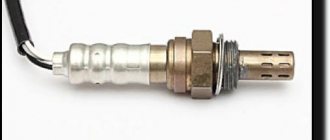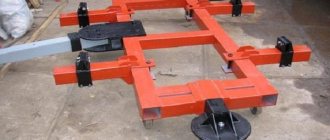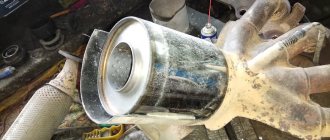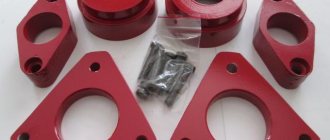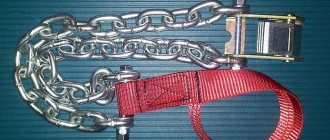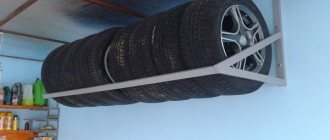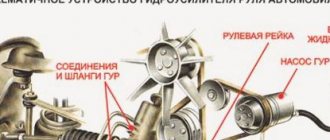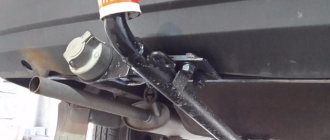The catalyst is one of the elements of the exhaust gas removal system. Most often it is located on the receiving pipe or behind it. The catalyst can quite significantly reduce the emissions of harmful substances, but at the same time the power of the power plant is lost. To avoid this, some car enthusiasts decide to make a flame arrester with their own hands and install it instead of a catalyst.
Automotive catalyst: purpose, principle of operation, types
The catalyst is located in the exhaust system and performs the function of removing and pre-purifying gases.
Inside the device, toxins are converted through chemical reactions into less harmful substances. This treatment results in minimizing environmental pollution.
The catalyst is activated as a result of heating, so it does not function when the engine is cold started. It operates in close symbiosis with oxygen detectors.
Thanks to them, the optimal ratio of the composition of the mixture consisting of gasoline and air is formed, which, depending on this, becomes leaner and enriched.
The detectors, guided by the available readings, control the catalyst located between the muffler and the engine.
It is provided to be covered with a special screen, since as a result of strong heating it becomes very hot. The unit can be in several states:
1.Working. Characterized by the normal condition of the car. The error light does not light up when the engine starts.
2. Half working. Traction periodically disappears, the engine becomes less responsive at high speeds.
The car starts worse when started hot and it becomes necessary to repeatedly drive the starter.
When you press the gas pedal, the tachometer needle cannot overcome the 4 mark, and fuel consumption increases.
3. Non-working. It is in such a situation that the catalyst must be replaced, since the vehicle begins to stall immediately after starting the engine or does not start at all.
Attention! You can identify a non-working condition by placing your hand in the pipe when the vehicle is started, checking the release of gases; if this does not happen, then the system does not function.
There are several types of neutralizers:
- tripartite;
- for lean fuel mixtures;
- bilateral;
- for diesel engines.
Double-sided models can neutralize unburned gasoline and carbon monoxide. Three-way modifications additionally break down nitric oxide, releasing oxygen from it. Diesel analogues prevent soot emissions.
We remove the catalyst and install a flame arrester. Video:
Installation of the blende
Decoys can be mechanical or electronic.
The mechanical blende is essentially a mini-catalyst that is screwed in together with the oxygen sensor. It is easy to install, but, unfortunately, it is not suitable for all cars.
This type of lambda probe also has its own service life - on average up to 20 thousand km. mileage
Electronic decoy is a full-fledged emulator of sensor signals with a microcontroller. It acts either to average the readings of a real “oxygen tank”, or to synchronize the readings with the first sensor.
Installing an electronic emulator
Electronic deception is more universal in the sense that it can be made for almost any car model. True, it also has more disadvantages: it is not possible to take into account all engine operating modes, so deviations in its operation are inevitable. Well, since this is electronics, problems with the emulator itself are inevitable.
Chip tuning and software shutdown of the catalyst
Chip tuning or ECU flashing - replacing the factory program of the control unit with a modified version. To programmatically remove the catalyst, the factory firmware disables control of the device using oxygen sensors, and adjusts fuel maps and torque models. Euro-2 firmware disables the second oxygen sensor and allows you to cut out the rear catalyst (bank 2), Euro-0 firmware disables the first lambda probe and allows you to remove the catalyst in the manifold (bank 1).
Disabling the catalyst in the ECU is a mandatory step when removing the device. This allows you to configure the engine to operate correctly and eliminate errors forever. Instead of a catalyst, a flame arrester or stronger is usually installed. You can further tune the exhaust system by installing a spider.
Installed flame arrester and new corrugation on Hyundai Tucson 2.7
An additional advantage of chip tuning will be improved gas pedal response, increased power and torque. This way you will achieve several goals at once: save on replacement costs and significantly improve the dynamics of the car.
How to disable and remove the catalyst on the Kia Sorento 3.3:
What happens if the catalyst is completely removed from the car?
This issue is almost a priority for most vehicle owners. Many people believe that the solution to all problems will be to install a direct flow instead of a used converter. But, in addition to the fact that this will lead to a significant increase in noise, the exhaust gases will constantly be at a high temperature, and this negatively affects the operation of other components of the car.
On many modern cars, a special sensor is installed along with the catalytic converter, the removal of which will certainly cause an error signal to appear. Before dismantling the neutralizer and sensor, it is best to consult with a specialist who will help in solving this problem, since this will require an integrated approach.
It is worth noting that in accordance with the International Euro-4 standard, a special lambda probe is installed on vehicles, without which the power unit will begin to operate incorrectly, and an error message will constantly light up on the display. To ensure correct operation of the engine, you will need to install a special “trick” and reflash the car’s ECU. As you can see, removing a catalytic converter from a vehicle exhaust system without consequences is not so easy.
The principle of operation of the flame arrester
During operation, the flame arrester receives exhaust gases that enter the exhaust system, processes them and removes them. At the exit, the temperature of the gases becomes significantly lower, and their speed drops significantly.
In addition, the flame arrester breaks the primary flow of gases that come from the collector. This approach is used for the purpose of stable operation of the main resonator.
In addition, the flame arrester mixes all the unstable flows ufpjd from the cylinders into one stable flow. Thanks to the design of the body of the part itself, the flame arrester significantly reduces the level of noise that appears inside it due to the beating of gases.
Design Features
The flame arrester body consists of two parts - external and internal.
To ensure that unnecessary noise does not appear during operation of the exhaust system, special noise reduction systems are used.
The noise reduction system of the flame arrester is conventionally divided into 2 types:
Unfortunately, high temperatures cause fillers to burn out very quickly. Their service life can be extended using a special stainless steel mesh. Using passive noise reduction is much more practical. To avoid unnecessary noise, the flame arrester body is made of two layers. In this case, all vibrations that the inner layer creates will be damped by the outer one.
The material from which the outer layer is made must be resistant to corrosion - sudden temperature changes, in combination with salts, kill even steel with aluminum impurities in a couple of years, so the body is needed from stainless, heat-resistant steel.
You should take into account the volume of the flame arrester itself, which determines how the following resonator and muffler will work. If there is insufficient volume in the resonator or muffler, when you sharply press the gas pedal, an unpleasant rattling sound occurs, and at the exit from the muffler the overall sound level becomes higher.
In the case where the muffler and resonator are of the direct-flow type, the rattling is usually not so noticeable.
Why is one thing replaced by another?
The catalyst can become unusable simply by exhausting its resource. This does not happen with new cars, but if the car was bought second-hand and managed to travel 150 thousand km or more, it means that the catalyst in it is seriously worn out. And since it is impossible to clean or restore it, there is only one way out: replacing it with a flame arrester.
High mileage is not the only reason for wear of the standard catalyst. It can also become unusable due to bad fuel. Unscrupulous sellers, trying to increase the octane number of their low-quality gasoline, add additives containing lead to it. Exhaust gases from such fuel cause overheating and subsequent melting of the catalyst sections.
Finally, flame arresters are installed in cars due to the high cost of branded catalysts. This is the most popular reason, especially now, when the price of catalysts has become simply prohibitive and can vary from 50 to 250 thousand rubles.
Pros and cons of installing a flame arrester instead of a catalyst
Advantages of installing a flame arrester instead of a catalyst:
• a flame arrester is a device that allows you to replace a failed catalyst and save significant money.
Thus, a flame arrester in a car exhaust system is a cheap alternative to a catalytic converter; • unlike the catalyst, the flame arrester is not so picky about the quality of the fuel, the proper operation of the engine and all its systems. In practice, the flame arrester will not be destroyed and melted in cases where the ignition or fuel system fails; • the flame arrester actually ensures the direct flow of exhaust gases - it follows that, in comparison with the catalyst, the exhaust gases will pass through the flame arrester much more easily and experience significantly less resistance along the way. Thus, the flame arrester provides the engine with more free “breathing”, which in some cases will allow achieving, albeit a small, but still quite noticeable increase in engine power. Disadvantages of installing a flame arrester instead of a catalyst:
• after removing the catalyst, the exhaust system is no longer able to reduce the level of harmful emissions into the atmosphere during vehicle operation; • when starting a cold engine and then after warming it up, there may be a smell of exhaust gases, which is especially important for those who warm up the car in a garage or in a closed parking lot; • also, after replacing the catalyst with a flame arrester, some elements of the exhaust system located behind the flame arrester will wear out somewhat faster due to stronger heating; • the process of installing a flame arrester itself can be fraught with certain difficulties, since such installation will require welding equipment, so such work cannot always be done by hand. Due to the above facts, many car owners install a flame arrester on their car instead of a catalyst. A flame arrester can quite successfully replace an expensive new catalyst, and the obviously increased durability of the flame arrester predetermines the choice in favor of this particular device. The main disadvantage of using a flame arrester remains the deterioration of some environmental indicators of the vehicle.
Video: Replacing the catalyst with a flame arrester. Advantages and disadvantages. Just something complicated
How to solve a problem?
The issue with a failed catalyst can be resolved in one of the following ways:
- Purchase and install an expensive original neutralizer.
- Use a universal part.
- Make a flame arrester with your own hands from a catalyst and install it on a car.
Note that each of the listed options has both its pros and cons. Let's describe in more detail the last item on the list - making your own flame arrester from a used exhaust gas neutralizer.
Benefits of replacement
Replacing an expensive catalytic converter with a cheaper flame arrester makes a lot of sense.
The following advantages can be highlighted:
- The cost in the second case is 7-9 times lower, so the savings are obvious here.
- The catalyst reduces the power of the power unit because it creates an obstacle to the passage of exhaust gases, because of this, the “horses” can decrease by up to 7%. On the other hand, when replacing, the exhaust flow encounters virtually no resistance.
- The absence of an expensive filter element makes it possible to use gasoline with a lower octane number, since the more reliable, durable design is resistant to aggressive technical fluids.
- The flame arrester is characterized by strength, reliability, and durability. The possibility of its burning out and the occurrence of corrosion foci is practically eliminated.
Thus, the advantages of replacement are not too many, but they really work. Unstable operation of the power unit can be caused by incorrect settings of the electronic control unit, so it is necessary to make a new electronics setting when replacing devices.
What and how to replace the oxygen sensor?
If the catalytic converter malfunctions in vehicles, a corresponding signal appears on the instrument panel, which is transmitted to the control unit by a special oxygen sensor, or lambda probe. In order for all systems to work correctly and the error signal no longer occurs, it is necessary to use the so-called “decoy”. The most common mechanical type of such devices.
Note that the operation of the “falsehoods” is based on the principle of limiting the volume of exhaust gases, which is constantly monitored using an appropriate sensor. Thanks to this, there is significantly more oxygen in the car’s exhaust, and the system can function correctly.
The manufacturing process of such a part will not be difficult. It is enough to install a so-called spacer at the location of the lambda probe and catalytic converter, and move the second lambda slightly away from the catalyst. The exhaust gases that will pass through the spacer lose the concentration of harmful impurities and substances in them, and the oxygen sensor moved from the converter will begin to record the normal oxygen concentration and issue a corresponding signal.
It turns out that making a reliable and functional flame arrester yourself and installing it instead of an expensive catalyst is not so difficult. Moreover, such a homemade element will not cause any harm not only to the exhaust tract and power unit of vehicles, but also to the environment.
Preliminary nuances
Let's start with the simple concept of a catalyst, which for some reason they want to replace with their own hands or the hands of a craftsman with a flame arrester. The catalyst is a device that is part of the exhaust system. It serves to purify gases produced during fuel combustion from all kinds of impurities.
But if this device breaks down or becomes dirty, returning it to its original level of performance is not so easy. In fact, car owners make one of 2 decisions. In the first case, they buy a new part and install it in place of the old one. The second option is to replace the catalyst with a device called a flame arrester. He's a strongman. At the same time, there is a lot of controversy and talk around the second method. Motorists sometimes do not understand why they should do this, what such modification will do and whether it will worsen the performance of the car.
Car enthusiasts are divided into 2 camps. Some argue that installing a stronger is an excellent tuning solution. Others are confident that such modernization will only cause harm.
But how dangerous would it actually be to remove the catalyst? And if this is harmful, then why do service stations actively offer this service in Yekaterinburg, St. Petersburg, cities such as Moscow, Voronezh, Volgograd and other parts of the country? And the price isn't that bad.
It's all about the myths that have formed around flame arresters. They look like this:
- the motor begins to quickly fail;
- the muffler breaks down;
- the engine is very noisy;
- exhaust gases become more dangerous in their composition;
- great harm is caused to nature;
- in the cabin you can be poisoned by the exhaust;
- the engine consumes fuel in huge quantities;
- motor life is reduced significantly;
- the exhaust system lasts quite a bit, etc.
But it was not in vain that I focused on the fact that these are myths. Most of them are very far from the truth.
Helpful information
The presence of catalysts in modern cars is due to the desire to ensure control over exhaust gases, more precisely, the presence of substances harmful to humans in them. CO2 gas is recognized as the most dangerous gas for the body. The catalyst limits the emission of this gas into the atmosphere, providing cars with the necessary environmental friendliness.
Quite strict European standards
regulate this indicator in such a way as to achieve, if not completely harmless, then the maximum safe amount of harmful substances.
The above reasons are enough
, so that domestic car enthusiasts seriously think about finding an alternative that is free from the listed disadvantages. This alternative was a flame arrester - a device that is in many ways similar to a catalyst, but has a direct-flow design, which makes it possible to ensure, in addition to environmental requirements, the initial engine power, as well as reduce fuel consumption.
That's it, the flame arrester is ready
. All that remains is to coat it with an anti-corrosion compound and install it, having first removed the catalyst. Here you need to keep in mind that in many modern cars the catalyst is equipped with a special sensor, the removal of which can trigger an error on the control unit. It is advisable to consult with specialists on this issue.
As you can see, installing a flame arrester instead of a catalyst with your own hands is quite simple. The main thing is extreme accuracy and diligence, without which, however, no work should be done.
Which flame arrester is better to choose?
When choosing a device, look at its shape. Flame arrestors come in flat and round shapes. With a round device, the car will drive silently. The flat version is suitable for those who want their car to be heard even in the neighboring yard when starting the engine.
The device must have a diffuser installed. If it is present, the requirements for the heat resistance of the steel used are reduced. It is better not to buy homemade devices. The quality of the steel from which they are made, as a rule, leaves much to be desired.
When choosing, pay attention to the manufacturer, because the designs of different brands have differences. For example, Sprint products are highly resistant to corrosion due to the use of stainless steel and aluminum. But the MG-RACE company makes components from high-quality silicon fiber.
The principle of operation of a flame arrester is similar to that of a catalyst, but is simpler in design. And it looks the part. Using a flame arrester has many more advantages than disadvantages, and the main advantage is its low cost.
Making your own flame arrester
Be sure to check the material for strength. Hold the sponges over the flame for a few minutes. For construction, use the one that has retained its elasticity after testing.
To make a good flame arrester yourself, you will need two steel pipes of different diameters, one of which must exactly match the exhaust pipe of the muffler. Stainless heat-resistant metal is not so easy to find, and this material is also quite expensive, so we will use an old used muffler instead. To work you will need:
- welding machine;
- metal brushes;
- grinder with cutting wheel;
- drill;
- a set of brushes (the same ones used for washing dishes).
We begin work by dismantling the car muffler, since we need to cut out the old catalyst. A pipe of smaller diameter must completely match the size of the dismantled catalyst, since in the future the flame arrester made will be installed in its place.
A pipe with a larger diameter should be shorter (by about 5-6 cm, in order to make an indent of 2.5-3 cm on each side). It is necessary to make cuts on each side, since they will need to be folded and welded. Next, you need to make holes on a pipe with a smaller diameter (each of them should be 3 mm in diameter, for which it is enough to select the appropriate drill).
Installing a flame arrester
If we are talking about replacing the catalyst, then the main reason why they replace it with a flame arrester, and do not weld a simple pipe of the required diameter in the place where this element of the exhaust system is installed, is that when installing a simple pipe, the vibration of the car will increase significantly and the noise during engine operation. Also, the temperature of the exhaust gases will be distributed to other elements of the system, which will lead to rapid wear of its components.
When installing a flame arrester, you must pay attention to the following points:
- How is a used catalyst or flame arrester installed? Is it bolted, clamped, or permanently welded to the pipe? If fastening is done with bolts or clamps, then the gaskets on the flanges must be replaced. If the element is simply welded to the pipe, then it must be cut off and the operation of welding the new part must be entrusted to trusted specialists. It’s better not to do this yourself if you are an amateur welder; experience is needed here.
- The system must be completely sealed and well secured, therefore, after installation work has been completed, it is better to seal the seams and joints with a special sealant.
- Do not tighten the pipe elements too much; this may lead to deformation of the muffler line and squeezing out the gaskets.
- If you install a flame arrester instead of a catalyst, then it is better to install a collector one, which is specifically designed for installation next to the exhaust manifold, where catalysts are usually located.
- You should also pay attention to the car engine. If the cylinder volume exceeds 2 liters, then a universal flame arrester cannot be installed on such a car; either a standard one, specifically for the brand and technical characteristics of this car, or a homemade one will do.
- On cars with a lambda probe (a sensor for measuring the percentage of oxygen in exhaust gases), you need to pay attention to the place where the sensor is installed; if it is installed only in the exhaust manifold, then there will be no problems with it, but if the sensor is installed after the catalyst, after replacement on the flame arrester, it will be necessary to make a modification in the electronic control unit or install a decoy element in front of the sensor.
Video: installing a flame arrester yourself
Why is it necessary to change the catalytic resonator?
It is known that the catalytic resonator is an element of the exhaust gas exhaust system, which can be located behind the exhaust pipe or directly on it.
To reduce the amount of harmful substances, which are contained in considerable quantities in exhaust gases, a catalyst is installed. However, this entails a loss of power produced by the motor.
Therefore, you can make a flame arrester with your own hands, which can replace the catalyst. Before we look at how a flame arrester can be made, it is necessary to understand what a catalyst is needed for and its main disadvantages. So, this element reduces the energy of exhaust gases and reduces their temperature, and also acts as a kind of filter that brings the level of toxicity of the exhaust to certain standards. Since the gases are removed very quickly and their temperature is quite high, the catalyst quickly fails.
In turn, the car does not accelerate enough, and there is also a significant excess consumption of fuel consumed. If the catalyst is completely removed from the exhaust system, then soon the gases in the muffler can will burn through the metal and a hole will form, so it is advisable to install a flame arrester instead.
About the benefits of a flame arrester
The flame arrester allows gases to escape almost without delay, so the car does not suffocate. This design solution does not have a detrimental effect on the operation of the engine; moreover, the flame arrester installed instead of the resonator lowers the temperature of the exhaust gases. This device has a number of advantages:
- the car operates stably without loss of power and excessive fuel consumption;
- exhaust speed and temperature are significantly reduced;
- noise level decreases;
- beating decreases.
The catalyst installed in the exhaust system has one undeniable advantage: unlike a flame arrester, it provides the necessary level of exhaust oxidation. However, a flame arrester installed instead of a resonator reduces exhaust energy and lowers its temperature.
Design Features
Its body has a double design, which you can make yourself from heat-resistant stainless steel. The flame arrester allows you to effectively suppress the occurrence of vibrations. In addition, this technical solution ensures direct exhaust flow and no delay. The resulting vibrations that form in the inner layer are suppressed by the walls of the outer layer of the flame arrester.
Assembly of the flame arrester
A large pipe should be 30-40 mm larger in diameter. After holes are made around the circumference of the small pipe, it must be cleaned with a metal brush and inserted into the large pipe (strictly in the middle). The larger pipe must be placed with the same indentation on each side relative to the smaller one, and then the pre-cut parts should be folded and welded (the seams are also welded hermetically).
Next, turn the pipes with the unwelded side facing you: you will need to put dish brushes on the smaller pipe, after which they need to be compacted tightly inside the resulting “glass”. After this procedure, you need to bend the petals to the smaller pipe and weld it to it in the same way (do not forget about the seams). Welding must be done carefully to avoid leaking joints. The finished flame arrester must be thoroughly cleaned with a brush to remove dirt and rust, and then coated with silver paint (spray cans can be used).
Now it's time to reassemble the old exhaust system. A newly manufactured flame arrester must be welded to the place where the catalyst was previously installed. Then the exhaust system is installed in its original place. It would be a good idea to treat its surface and coat it with a heat-resistant anti-corrosion compound.
